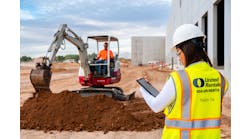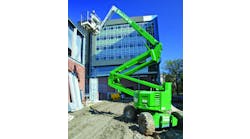ConExpo Draws Strong Crowds and Buying Activity
The ConExpo-Con/Agg show in Las Vegas last month was viewed as a great success by manufacturer and other exhibiting personnel interviewed at the show by RER. While final attendance figures weren't immediately available, floor traffic at both indoor and outdoor exhibits was viewed as robust.
The 2008 ConExpo show drew more than 144,600 attendees from more than 130 countries, covering more than 2.28 million net square feet of exhibits, with 2,182 exhibitors. Although show organizers, the Association of Equipment Manufacturers, said attendance figures were about 125,000, exhibitors were happy with the turnout. AEM said international visitors were even higher than at the 2008 show. Exhibitors expressed strong enthusiasm regarding the upbeat attitude of show visitors, who showed an optimism not felt in North America over the past two years, while allowing for lingering economic uncertainty. Buying activity was strong, the quality of attendees was viewed as excellent and the quality and quantity of leads was viewed favorably.
— Michael Roth
JCB Outlines Global Investments, Big 2010 Revenue Increase
After enduring what JCB deputy chairman John Patterson termed “the worst downturn our industry has experienced in 40 years,” JCB reported revenues of $3.2 billion in 2010, at a press conference at the ConExpo show in Las Vegas last month. The revenue was a 45-percent year-over-year increase compared with 2009. JCB sold 51,000 machines in 2010 compared with 36,000 in 2009.
JCB's strong results in 2009 were led by the BRIC countries — Brazil, Russia, India and China — and much of JCB's investment in the coming years will be in those countries. In Brazil, where demand grew 47 percent last year, Patterson said, JCB is building a $100 million factory in Brazil to produce excavators and backhoe loaders. The 350,000-square-foot factory is being built in Sorocaba, just a few miles from JCB's existing factories there. JCB has been producing backhoes in Brazil since 2001 and excavators since 2010.
“The Brazilian market for excavators grew by 65 percent last year,” Patterson said. “Its market for backhoe loaders grew 47 percent.”
JCB sold more than 21,000 machines in India, where JCB has had a strong presence for more than 30 years with four factories. The company invested in an engine production facility in Ballabgarh, Delhi, marking the first time JCB has produced Dieselmax engines outside of its plant in Derbyshire, U.K. The engines are being used in Indian-built JCB products and from now on every JCB backhoe loader in India will be powered by a JCB engine to meet new local emissions legislation.
Patterson said JCB had 80-percent market share in the Chinese hydraulic excavator market and now has 27 dealers with 106 outlets there.
JCB invested $30 million in its global product support structure. The company is about to open a parts warehouse in Prague to serve Central Europe and Poland. It's the company's 16th parts warehouse, having recently opened facilities in Fontana, Calif., and Dubai, U.A.E., serving the Middle East and north and east Africa.
The company's efforts to grow its dealer network in the United States and North America appear to be bearing fruit. Patterson said the company now has 85 dealerships in North America with about 250 outlets, with none also selling competing products.
JCB unveiled at ConExpo the first models of a new range of 16 tracked and wheeled skid-steer loaders, engineered and manufactured at JCB's North American headquarters in Savannah, Ga., part of a $40 million investment. It also showed its new 512-56 telehandler, which Patterson told RER was designed for the rental market.
“The 512-56 caps off our line of five, high-boom, lift-and-place Loadalls with capacities ranging from 6,000 to 12,000 pounds,” Patterson said. The unit can elevate a maximum load of 12,000 pounds with a maximum lift height of 56 feet.
— Michael Roth
Doosan Displays Interim Tier-4 Machines at ConExpo
Doosan displayed three interim Tier 4-compliant machines and a display engine at ConExpo last month in Las Vegas. The machines included a DL450 wheel loader, a DX300LC crawler excavator and an MT41 articulated dump truck. An iT4-compliant Doosan engine was also on display.
“As 2011 progresses, Doosan will continue to provide further emission-related information as necessary to keep our customers informed and educated on our progression through this endeavor,” said Aaron Kleingartner, segment application marketing manager.
Kleingartner said an engine technology that Doosan already utilizes extensively on higher horsepower engines is high-pressure common rail fuel injection systems. HPCR was applied to many Doosan models with Tier-3-compliant engines and will be an enabler for application of further technologies needed for iT4 and Tier-4 compliance, along with cooled exhaust gas recirculation, diesel particulate filters, diesel oxidation catalysts or selective catalytic reduction systems.
“It should be noted that iT4 and Tier 4, as they apply to Doosan heavy equipment, is not one set of emission standards and one compliance deadline,” Kleingartner said. “IT4 and Tier-4 emission standards and compliance deadlines vary considerably among different engine horsepower ratings.”
Currently, he said, iT4 compliance for Doosan products with 50- to 75-hp engines has already been completed. That's because iT4 emission standards are less stringent to this range of engine horsepower compared to higher (>75) horsepower engines, and changes required to achieve compliance for engines in this class were less complex.
For the rental market, the company introduced its new Doosan DL200TC tool carrier and DL250 High Lift wheel loader. The DL200TC features a parallel-lift linkage system designed to move pallets, pipe and other materials around jobsites. The DL250 High Lift wheel loader is designed to load stockpiled, light materials such as grain, fertilizer, coal or waste into high-sided trucks or hoppers.
The DL200TC provides visibility down the center of the lift arms, allowing the operator to see the ground, truck or work area in front of the machine when placing loads. In addition, the parallel-lift linkage system keeps the work tool flat as it is lifted rather than rolling back, an advantage when lifting pallets and other loads that need to stay level.
Built around a Tier 3-compliant, 143-hp, 6-cylinder Doosan diesel engine, the DL200TC has an operating weight of 25,708 pounds with a standard 2.6-cubic-yard bucket. Dump height is 8 feet, 11 inches, and dump reach is 3 feet, 1 inch. The DL250 features a Tier-3-compliant, 6-cylinder Doosan DL06 162-net-hp diesel engine. The advanced engine design features a high-pressure common rail direct fuel injection system and electronic control that results in increased power and torque.
Like all Doosan wheel loaders, the DL200TC and DL250 High Lift feature full powershift transmissions with manual, automatic and semiautomatic (with “kick down” for first gear) modes. Transmission and engine operation can be easily diagnosed by connecting a laptop computer.
Doosan Infracore Construction Equipment America, headquartered in West Fargo, N.D., markets the Doosan brand of products, which includes large excavators, wheel loaders and articulated dump trucks.
— Brandey Smith
Perkins Introduces Its First Tier-4 Final Engines at ConExpo
Perkins launched its first Tier-4 Final emissions-compliant engines at the ConExpo trade show. The new 400F, the latest addition to its 400 Series range, meets Tier-4 Final/Stage IIIB regulations, which take effect in January 2013 in the EPA above 25 horsepower and in the EU above 49.5 horsepower.
The engines' compact three- and four-cylinder lineup features a 97-percent carryover of components from the previous tier engines. With minimum changes, little or no machine re-design is required for OEMs.
The engines add a compact after-treatment system, with flexible mounting arrangements to ease installation. The after-treatment uses passive regeneration, with systems in place to provide active regeneration capability, effectively burning the soot in the diesel particulate filter to keep performance levels high. The 400F series delivers fuel-consumption improvements, minimizing running costs and heat rejection, which provides ambient clearance.
Perkins marketing manager Allister Dennis told RER the engines will initially be manufactured in Perkins' Griffin, Ga., plant, and later, as demand grows, in the U.K., China and Japan.
— Michael Roth
Cummins Unveils Tier-4 Final QSL9 at ConExpo
Cummins Inc. revealed the latest generation of the QSL9 engine at ConExpo, which is capable of meeting near-zero emissions levels. This 9-liter engine achieves 2014 EPA Tier-4 Final and EU Stage IV standards with an ultra-clean after-treatment system, combining the Cummins Compact Catalyst with Selective Catalytic Reduction.
With up to 400-hp output, the QSL9 is designed to retain the higher output and faster engine response demonstrated by the Tier-4 Interim QSL9. Fuel efficiency at Tier-4 Final will be further improved over that achieved for the Tier-4 Interim engine.
The CCC-SCR ultra-clean after-treatment system is specifically configured to provide a more compact and flexible equipment installation for Tier-4 Final. The Cummins Compact Catalyst, previously used for ratings below 174 hp, is scaled-up in size for the 9-liter platform. Combined with SCR, the after-treatment system achieves near-zero emissions with fully passive, flow-through operation.
In addition to the QSL9, the CCC-SCR system will be utilized by the QSB6.7, QSB4.5 and QSB3.3 engines to offer a common after-treatment solution from 75 hp to 400 hp. The scalability of the CCC-SCR system enables sizing to be configured for specific power outputs across the 3.3-liter to 9-liter engine range.
“We listened to equipment manufacturers before developing our Tier-4 Final architecture for the QSB3.3 to QSL9 product line, and the clear message we heard was to focus on reducing installation complexity as much as possible — while also retaining the high power output and performance offered by our Tier-4 Interim products,” said Jeff Weikert, vice president - Cummins MidRange Engineering.
“I am very pleased to say that with the CCC-SCR ultra-clean after-treatment system, we are able to meet and exceed our customer expectations for Tier-4 Final. With the addition of SCR, we now have the ability to precisely balance NOx reduction between after-treatment and cooled Exhaust Gas Recirculation on the engine — giving us more control over the combustion formula than ever before.”
To meet Tier-4 Final in 2014, particulate matter reduces to 0.02 g/kW-hr and oxides of nitrogen reduce to 0.40 g/kW-hr. Compared to Tier-3 emissions levels, this represents a 90-percent reduction for both PM and NOx.
The SCR system developed by Cummins for Tier-4 Final is a next-generation design that moves beyond the SCR technology currently in use for Tier 4 Interim. The system incorporates a copper zeolite-based catalyst capable of up to 95 percent NOx conversion and able to operate more efficiently at lower temperatures. The system features advanced sensors to provide full closed-loop control. Diesel Exhaust Fluid dosing levels are minimized with enhanced mixing in the decomposition pipe.
The CCC-SCR after-treatment will be available in multiple configurations, including switchback, horizontal and vertical. Optimization work will continue to refine after-treatment packaging and evaluate innovative solutions to further enhance installation flexibility.
Headquartered in Columbus, Ind., Cummins Inc., a global power leader, is a corporation of complementary business units that design, manufacture, distribute and service engines and related technologies, including fuel systems, controls, air handling, filtration, emission solutions and electrical power generation systems.
— Brandey Smith
JLG Introduces 150-foot Boomlift and Other New Products at ConExpo
JLG Industries unveiled new products and partnerships, including its 150-foot boomlift at ConExpo in Las Vegas in March. The 1500SJ is the first straight boomlift that elevates operators to 150 feet requiring only a weight permit to transport. The telescoping jib provides work envelope flexibility and horizontal and vertical reach extending to 25 feet. The 1500SJ delivers dual 1,000/500-pound capacity, three steering modes and advanced systems to assist in safely positioning the platform.
Other new products include:
- 340AJ: The unit features a 500-pound capacity, up to 34 foot lift height and 20 feet of up-and-over reach, as well as a steel hood for added durability, a Tier-4 diesel engine and enhanced terrainability.
- Compact crawler booms: available in three models with working heights ranging from 45 to 75 feet, the new units feature a tracked wheel carriage that climbs steps and a narrow chassis for access through gates, yards, standard doorways and public buildings. The units deliver a 440-pound capacity, up to 37-foot horizontal reach and electric and combustion combination power for energy efficiency.
- Toucan: The new direct electric drive in the Toucan T26E provides longer battery life and more duty cycles. Improved controls facilitate operators reaching up and over obstacles in tighter spaces, and an AC motor ensures quieter operation and lower maintenance costs.
- Steel hoods: Most JLG engine-powered boomlifts produced after Oct. 1, 2010, feature new steel hoods that are more durable, minimizing maintenance costs. Factory-approved retrofit kits will be available for engine-powered boomlifts built prior to Oct. 4, 2010.
- Firestone tires: JLG and Bridgestone Americas Off-Road Tires division recently collaborated to create the all-new Firestone DuraForce MH tire. All three lines of JLG telehandlers are equipped with the longer-lasting tires, which feature a unique self-cleaning tread design for enhanced terrainability.
- FS60 LiftPod: The brand new addition to the LiftPod line of aerial work platforms combines the portability of a ladder with the stability of a work platform. The 30-inch base enables operators to move the LiftPod through doorways. The FS60 features an enclosed platform with a 12-foot working height and 6-foot standing height, allowing workers to move hands-free in a 360-degree range of motion.
JLG is based in McConnellsburg, Pa. Its parent company, Oshkosh Corp., is based in Oshkosh, Wis.
Michael Roth
Russian Rental Business Leaders Attend The Rental Show
From B2B-Rent in Russia, Aliza Azhaurova, director of development and Nikita Krotkiy, president, stopped by the RER booth at the Rental Show. Azhaurova and Krotkiy, who recently organized a conference on equipment rental in Russia, greatly enjoyed the wide variety of products and services shown at the ARA show, as well as the warm Las Vegas weather.
— Michael Roth
Thompson Pump Introduces New Priming System with Oil-less Vacuum Technology at ConExpo
Thompson Pump, based in Port Orange, Fla., showcased a revolutionary priming system with OVT (oil-less vacuum technology) configured with the new John Deere IT4 (Interim Tier-4) engine at the ConExpo 2011 tradeshow.
The groundbreaking OVT priming system offers multiple improvements to the traditional vacuum priming system. While both allow for a basic pump to prime automatically, the OVT does this more efficiently with lower maintenance and higher air handling for faster priming. In addition, the OVT system's non-contacting rotors eliminate internal wear, which increases longevity and provides the reliability of no decrease in performance over time.
The OVT system offers lower maintenance and operating expenses because the system is dry running — no re-circulating oil is needed. Eliminating the oil, in turn, eliminates any possible smoke, mist, or pollution that traditional priming systems may experience — offering a much-improved eco-friendly alternative to prior technology. Traditional vacuum priming systems require service every 5,000 hours. The OVT priming unit only requires service every 20,000 hours, the company said.
The Thompson OVT system has high vacuum capability with deeper suction lifts of 28.4 inches and is designed to maintain high vacuum at lower speeds. This air-cooled priming system has no water levels to check and no cooling system to maintain unlike traditional vacuum priming systems. These capabilities allow the OVT priming system to perform in a variety of applications from sewer bypassing to wellpoint dewatering.
Most interestingly, the Thompson OVT priming system is tolerant to accidental liquid carryover. Prior vacuum priming systems would be destroyed if liquid carried over. In turn, this makes the OVT priming system the most rugged priming system on the portable pump market today, according to the company.
— Michael Roth
Genie Introduces 40-Foot Drivable-at-Height Scissorlift
Genie launched a new series of 69-inch-wide rough terrain scissorlifts at The Rental Show in Las Vegas, and also featured the new machines at its booth later last month at ConExpo. The three new models — GS-2669 RT, GS-3369 RT and GS-4069 RT — are a significant redesign of the 68-inch series through increased capacity and improved jobsite performance. The new 40-foot model introduction is the only one of its kind in the market.
“In the competitive rental industry, our customers need equipment that will be in high demand by jobsite personnel for uses such as commercial construction and infrastructure improvements,” said Jeff Weido, senior product manager, Terex Aerial Work Platforms. “Customers can be confident in the quality of our new RT scissors series. The products address today's most intensive jobsite demands while offering excellent value and simplified service access.”
The new GS-4069 is the world's first 40-foot full drive-height rough terrain scissorlift in its class, the company said. Designed to increase end-user uptime while on the jobsite, the 26-foot and 33-foot models are also equipped with the full drive-height feature.
An increased platform work space of 13 percent gives end users more room to get jobs done more efficiently. The GS-2669 RT offers a 20-percent increase in lifting capacity from 1,250 pounds to 1,500 pounds, providing the end user with more lifting capability. The GS-3369 RT has a lifting capacity of 1,000 pounds; the GS-4069 RT has a lifting capacity of 800 pounds.
A standard front active-oscillating axle keeps all four wheels on the ground during operation, providing the user with more machine control and power when climbing hills and jobsite obstacles. Up to a 30-percent increase in horsepower from dual-fuel engines enables the machines to drive through sand, snow, mud and uneven terrain with ease.
In addition, wheel drives and high-efficiency piston motors were added to get more torque to the rear wheels, providing jobsite performance similar to the large Genie boom products.
Full swing-out doors provide easier service access to electronics, manifolds, hydraulics and engine.
The new Genie Rough Terrain Scissor Series will be available in ANSI markets beginning in the second quarter of 2011, and in CE markets in the third quarter.
Terex Corp. is a diversified global manufacturer with 2008 net sales of $9.9 billion. Terex operates in four business segments: Terex Aerial Work Platforms, Terex Construction, Terex Cranes and Terex Materials Processing & Mining.
— Michael Roth
Case Launches Alpha Series Skid-Steer and Compact Track Loaders
Case Construction Equipment launched its new Alpha Series line of skid-steer and compact track loaders at The Rental Show. The new Case machines are engineered to deliver best-in-class horsepower and breakout force.
The engines in the new Alpha Series skid steers, which included nine models, range from 46 to 90 hp, with rated operating capacities ranging from 1,300 pounds in the new class-size SR130 to 3,000 pounds in the SV300.
“Our new Case Alpha Series skid steers deliver industry-leading bucket breakout force — up to 8,585 pounds,” said Curtis Goettel, Case marketing manager. “When comparing 1,750-pound rated operating capacity machines, the industry's highest-volume class, the Case SR175 has more than twice the bucket breakout force of the current best-selling model in this size class.”
The new Case compact track loaders deliver 74 hp in the TR270 and 90 hp in both the TR320 and TV380. Rated operating capacities range from 2,700 to 4,200 pounds with a counterweight. The Alpha Series models also offer improved hinge-pin height, which positions the bucket higher to load trucks faster and easier.
The Alpha Series skid steers includes both radial-lift and vertical-lift models. The radial lift machines (designated with an R in the model name), are engineered for digging, prying and pushing, while the vertical lift models (designated with a V) are engineered for lift-and-carry applications. The Case Alpha Series includes six radial-lift skid steers, the SR130, SR150, SR175, SR200, SR220 and SR250, and three vertical-lift models, the SV185, SV250 and SV300.
As in the earlier 400 Series 3 models, the new Case compact track loaders feature a dozer-style undercarriage, engineered to hold fast on steep slopes and take command of muddy or sandy terrain. The undercarriage has a rigid track frame with fewer moving parts, so it is more durable and easier to maintain than suspension track systems.
The Alpha Series compact track loaders include two radial-lift models, the TR270 and TR320, and an all-new vertical-lift model, the TV380. The TV380 is a new class size to meet customer demand for a tracked version of the Case 465 skid steer.
The cabs on the new Case Alpha Series machines are 25-percent larger and feature an ultra-narrow wire side-screen design to improve operator visibility. Plus, the glass surface was increased to provide 360-degree visibility.
“The spacious Alpha Series cabs are ideal for the long, hard days operators spend in equipment,” Goettel said. “An increase of 25 percent makes a world of difference.”
The Alpha Series models also feature larger fuel tanks, ranging from 16 to 25.5 gallons, for run times between eight to 10 hours before refueling. And all Alpha Series models feature electro-hydraulic (EH) switchable controls.
Case is headquartered in Racine, Wis.
— Brandey Smith
Multiquip Hydrogen Fuel Cell-Powered Light Tower Wins WOC Innovation Award
Carson, Calif.-based Multiquip recently won a World of Concrete Most Innovative Product award for its model H2LT hydrogen fuel cell-powered light tower. The H2LT light tower was named the Editor's Choice in the General Tools and Equipment category.
“We are honored to receive The Most Innovative Product award,” said Torsten Erbel, vice president product management, engineering and customer support for Multiquip. “Multiquip's goal is to continue to provide innovative, high-quality products for today and the future. The H2LT is evidence of continued progress in this direction.”
Held annually at World of Concrete, the MIP Award Program showcases many of the new products exhibited. The MIP Program allows attendees and readers of Concrete Construction, Masonry Construction, The Concrete Producer and Concrete Construction Products a chance to vote for the products they judge as innovative. A panel of industry experts, many of whom serve on the World of Concrete Educational Advisory Board, reviewed and selected the MIP award winners. The editors reviewed and selected the products in terms of the innovation they bring to the industry.
The Multiquip H2LT light tower is environmentally friendly and pollution-free, allowing it to run indoors and can be operated for up to 68 hours at only 43 decibels at 23 feet. Because of the load following feature of the fuel cell, power is only produced as needed providing an improved fuel efficiency compared to conventional combustion engines running at full load at all times.
This is the second award for Multiquip's hydrogen light tower. In September 2010 the light tower was awarded the 2010 Federal Laboratory Consortium Award “Mid-Continent Region” for “Notable Technological Achievement.”
Production of the H2LT will start in Q2 2011.
Multiquip's comprehensive product portfolio encompasses light to medium construction equipment, power generators and lighting.
— Michael Roth
Kawasaki Presents Hybrid, Tier-4 Wheel Loaders at ConExpo
Kawasaki, which exhibited at ConExpo for the first time in its history, presented two new compact wheel loaders, with interim Tier-4-compliant Kubota engines, as well as a hybrid unit.
The 65Z hybrid wheel loader is the company's first entry into the hybrid market. Through the use of a hybrid torque converter system, the unit is designed to save power and regenerate energy during idling and braking. During the initial acceleration or idle periods, energy loss generated in the torque converter is converted to electric energy and stored in the capacitor, which will charge and discharge electric energy instantaneously rather than the delayed delivery of a conventional battery, the company said.
Kawasaki's new Tier-4 wheel loaders, the 85Z7 and 90Z7, include a number of innovative features.
— Michael Roth





